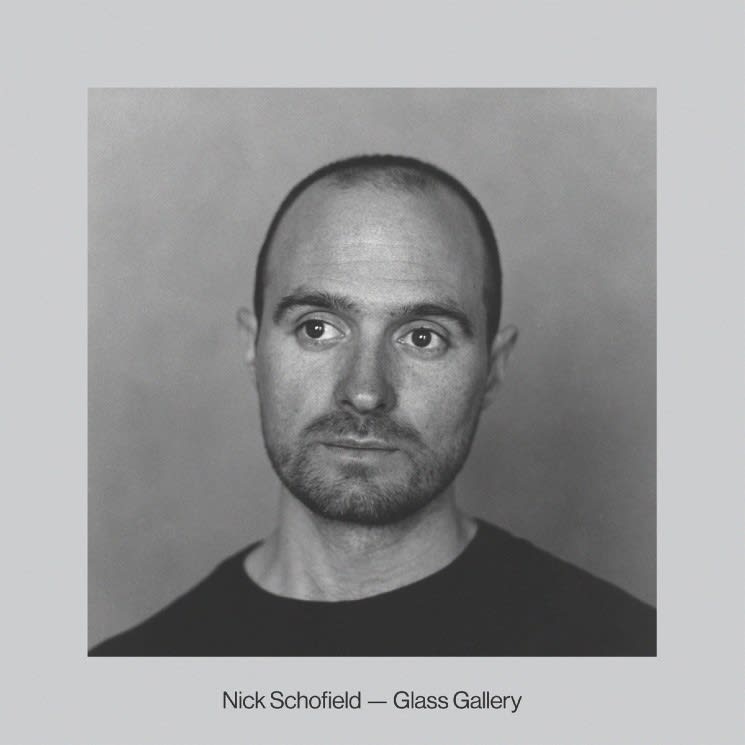When the National Gallery of Canada — the building itself, not the institution — was completed in 1988, then-Prime Minister Brian Mulroney called it "a living part of Canada." The massive Moshe Safdie-designed institution remains an awe-inspiring achievement, with its 53,265-square-metre surface of pink granite, concrete and glass sitting atop Nepean Point overlooking the Ottawa River. It's no surprise this Ottawa landmark, especially the cathedral-like Colonnade and the grand windows of the Great Hall, could inspire such an expansive and buoyant release as Glass Gallery, Ottawa-born and Montreal-based composer Nick Schofield's sophomore solo release.
Created on a vintage Prophet-600 synth, Glass Gallery is as much an exercise in restraint as it is one of expansion, pushing the limits of a single instrument in order to evoke the sense of grandeur and possibility that characterizes the experience of walking through the expansive halls of the National Gallery. The undulating topography of the Garden Court, meant to mimic pre-settlement Canadian landscape, inspires its namesake song, one of the album's briefest yet most engrossing moments. While "Kissing Wall" is as evocative as the name implies, rippling, echoing and looping into itself; one can almost see the waves bouncing off the sun-kissed surface.
The release of Glass Gallery comes at a time where appreciation for ambient music, and more specifically Japanese ambient from pioneers such as Hiroshi Yoshimura and Midori Takada, is at an all-time high. Schofield wears those influences well without succumbing to them, taking an approach akin to that of composer and programmer Laurie Spiegel, specifically referenced in the liner notes. Spiegel, who once touted the subversive nature of creating music using computers, was both precise and spontaneous in her work, culminating in the influential Music Mouse, an algorithmic musical composition software, and a career that continues to amaze and inspire.
With the prospect of a long, isolated winter, the levity and calmness offered by Schofield is a welcome respite, an album that can be equally appreciated through attentive or casual listening, following you easily from desk to sink, shower to walk. And while it does work in and out of order, as often ambient music can, Glass Gallery does reveal itself quite beautifully in its intended sequence. Where much instrumental music tends to unfold in a crescendo, Schofield resists the impulse and instead offers something closer to an abatement, peaking around mid-album track "Travertine Museum" before softly landing with closer "Key of Klee." Because of this, the album does actually work rather nicely when sequenced back-to-front for those looking for a more traditional listening experience. Ultimately, Glass Gallery marks a very confident step forward from Schofield's debut, Water Sine, while hinting toward even more creativity just bubbling under the still surface.
(Backward)Created on a vintage Prophet-600 synth, Glass Gallery is as much an exercise in restraint as it is one of expansion, pushing the limits of a single instrument in order to evoke the sense of grandeur and possibility that characterizes the experience of walking through the expansive halls of the National Gallery. The undulating topography of the Garden Court, meant to mimic pre-settlement Canadian landscape, inspires its namesake song, one of the album's briefest yet most engrossing moments. While "Kissing Wall" is as evocative as the name implies, rippling, echoing and looping into itself; one can almost see the waves bouncing off the sun-kissed surface.
The release of Glass Gallery comes at a time where appreciation for ambient music, and more specifically Japanese ambient from pioneers such as Hiroshi Yoshimura and Midori Takada, is at an all-time high. Schofield wears those influences well without succumbing to them, taking an approach akin to that of composer and programmer Laurie Spiegel, specifically referenced in the liner notes. Spiegel, who once touted the subversive nature of creating music using computers, was both precise and spontaneous in her work, culminating in the influential Music Mouse, an algorithmic musical composition software, and a career that continues to amaze and inspire.
With the prospect of a long, isolated winter, the levity and calmness offered by Schofield is a welcome respite, an album that can be equally appreciated through attentive or casual listening, following you easily from desk to sink, shower to walk. And while it does work in and out of order, as often ambient music can, Glass Gallery does reveal itself quite beautifully in its intended sequence. Where much instrumental music tends to unfold in a crescendo, Schofield resists the impulse and instead offers something closer to an abatement, peaking around mid-album track "Travertine Museum" before softly landing with closer "Key of Klee." Because of this, the album does actually work rather nicely when sequenced back-to-front for those looking for a more traditional listening experience. Ultimately, Glass Gallery marks a very confident step forward from Schofield's debut, Water Sine, while hinting toward even more creativity just bubbling under the still surface.
